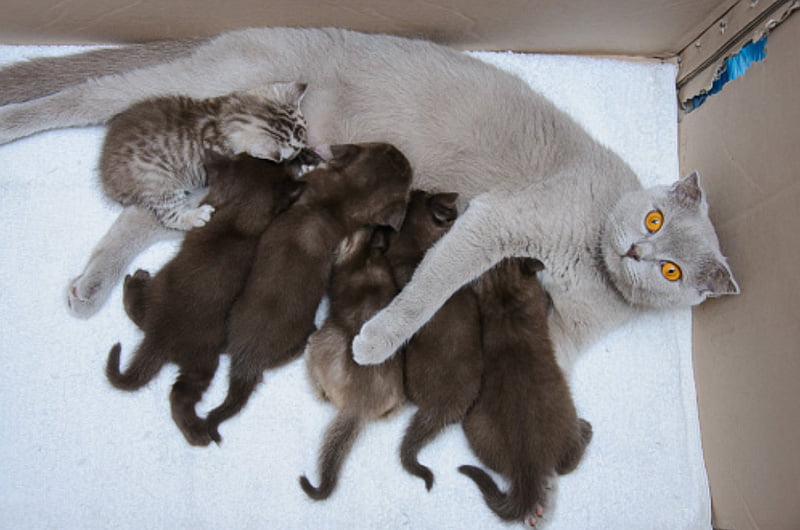By the time kittens are about three weeks old most begin to acquire the ability to regulate their body temperature. The mother can then spend more time away from the birth then. At seven weeks of age kittens are able to thermoregulate as well as an adult.

When kittens are born their body temperature is the same as their mother’s. Immediately after birth their core temperature drops several degrees Celsius depending upon the temperature of the environment in which they’ve suddenly been plunged. Within 30 minutes a kitten’s temperature will climb provided they can snuggle up close to their mother and the conditions are dry. Their body temperature will reach about 95°F-99°F (35.5°C-37.8°C).
Provided the kitten is healthy he/she should be able to maintain their body temperature at 10-12° above room temperature.
If the room temperature is below the recommended level say at 70°F (21°C) and the mother leaves her kitten for 30 minutes, the kitten’s temperature can fall. The kitten might become chilled quite quickly. This reduces metabolism and can be dangerous.

This is because most neonatal kittens do not have a lot of subcutaneous fat. Neither can they constrict the blood vessels at the surface of the skin to retain heat in their bodies. A further issue is that the heart rate of neonatal kittens is increased and they have few reserves. They obtain their energy from the meals. If they don’t eat frequently, they can become chilled.
And chilling is, on my research, the single greatest danger to young kittens. Therefore, the kittening box and the surrounding area should be kept at 85°F-90°F (29.4°C-32.2°C), for the first few weeks of the kitten’s life. After that it can be lowered a few degrees each week to 70°F (21°C) at the age of about six weeks. At that point, as mentioned, they are well on the way to having the ability to regulate their own temperature.
They will still obtain heat from their mother, from siblings, from the blanket and other bedding and sometimes a heat lamp over one corner of the kitten box. The temperature should be checked by placing a thermometer on the base of the kitten box.

Humility should be at around 55-65%. The best place for a mother to deliver her kittens is a kittening box. It should be located in a warm, dry, out of the way place which is not in a bright area and which is not near distracting noises. It can be made from strong cardboard. It should be large enough for the mother to move about in. A rectangular box about 24 inches (60 cm) long, 20 inches (50 cm) wide and 20 inches high is suitable. It should be more than big enough. It should have a removable lid. At one end, the advice is to cut out a doorway about chest high for the mother so she can step in and out without jumping.
An alternative is to make a box of wood. If you make it out of wood, you can also provide inside edges (5 cm high and 5 cm wide) which can be nailed around all four sides. This will allow kittens to instinctively crawl under them where they can be protected from being rolled over by their mother.
In order to make the box easy to clean it should be coated with a non-toxic washable preparation. Wood without some sort of coating is absorptive. Several sheets of newspaper can be placed at the bottom to absorb moisture. The advice is to not use bedding made up of straw or wood chips. This is because they can be inhaled by kittens and block their noses. Fleece blankets are easy to clean. Tight weave towels are also acceptable.
Ref: Wild Cats of the World at page 109 for age of thermoregulation and the remainder: Cat Owner’s Home Veterinary Handbook at pages 433 and 456.

